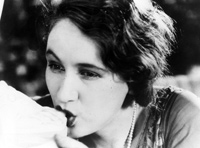L'Age d'or
Luis Buñuel

The documentary images of scorpions which open the film are followed by imaged of a loving communion... Punctuated with sequences apparently unrelated with the narrative, one minute a burning anti-clerical attack, another a satire of the decadent aristocracy, the film presents two lovers who are clearly outside of the margins laid down by society love and separate, in a discontinuous narrative punctuated with allegorical episodes.
With : Gaston Modot, Lya Lys, Caridad de Laberdesque, Max Ernst, Josep Llorens Artigas, Lionel Salem, Germaine Noizet, Pierre Prévert
Screenplay : Luis Buñuel (en partie en collaboration avec Salvador Dalí)
Image : Albert Duverger
Sound : Peter Paul Brauer
Editing : Luis Buñuel
Decors : Schildknecht
Screenplay : Luis Buñuel (en partie en collaboration avec Salvador Dalí)
Image : Albert Duverger
Sound : Peter Paul Brauer
Editing : Luis Buñuel
Decors : Schildknecht
Production : Le Vicomte de Noailles
Source copie : Centre Pompidou, Paris, Musée d'art modern, Centre de création industrielle
Source copie : Centre Pompidou, Paris, Musée d'art modern, Centre de création industrielle
L'Âge d'or (The Golden Age) is a pivotal film. Tinged with surrealism it already forges links with the narrative classicism later adopted by Buñuel. So images apparently disconnected from the real, hook onto a still tenuous narrative thread. L'Âge d'or marked the end of the Dalí-Buñuel collaboration. Furthermore, only the patronage of the Vicomte de Noailles made the financing of the film possible: "Here we are, suggesting making a film of about 20 minutes in length. Total freedom". If Un chien andalou (An Andalousian Dog) was entirely self-funded by the director, L'Âge d'or marks the beginnings of a more professional recognition for Buñuel. The "Buñuel style" comes out very clearly already in L'Âge d'or, particularly with the scene with Lya Lys and the statue, in which the famous foot fetishism so dear to Buñuel appeared for the first time.
